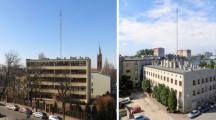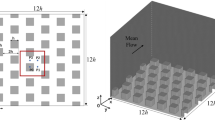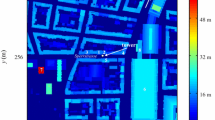Abstract
Wind and tracer data from the Oklahoma City Joint Urban 2003 (JU2003) and the Manhattan Madison Square Garden 2005 (MSG05) urban field experiments are being analyzed to aid in understanding air flow and dispersion near street-level in built-up downtown areas. The mean winds are separately calculated for groups of anemometers having similar exposures such as “near street level” and “on building top”. Several general results are found, such as the scalar wind speed at street level is about 1/3 of that at building top. Turbulent standard deviations of wind speed components and temperature, and vertical fluxes of momentum and sensible heat, are calculated from sonic anemometers near street level at 20 locations in JU2003 and five locations in MSG05, and from two rooftop locations in MSG05. The turbulence observations are consistent with observations in the literature at other cities, although the JU2003 and MSG05 data are unique in that many data are available near street level. For example, it is found that the local (i.e., at the measuring height) \(\sigma_{w}/u_{\ast}\) averages about 1.5 and the local \(u_{\ast}/u\) averages about 0.25 in the two cities, where \(\sigma_{w}\) is the standard deviation of vertical velocity fluctuations, \(u_{\ast}\) is the friction velocity, and u is the wind speed. The ratio of temperature fluctuations to temperature scale, \(\sigma_{T}/T_{\ast}\) , averages about −3 in both cities, consistent with similarity theory for slightly unstable conditions, where \(\sigma_{T}\) is the standard deviation of temperature fluctuations, and \(T_{\ast}\) is the temperature scale. The calculated Obukhov length, L, is also consistent with slightly unstable conditions near street level, even at night during JU2003. The SF6 tracer concentration observations from JU2003 are analyzed. Values of \(uC_{max}/Q\) for the continuous releases are calculated for each release and arc distance, where \(C_{max}\) is the 30-min average arc maximum concentration, Q is the continuous source emission rate, and u is the spatial-averaged wind speed in the downtown area. The basic characteristics of the JU2003 plot of averaged \(uC_{max}/Q\) agree reasonably well with similar plots for other urban experiments in Salt Lake City and London (i.e., at \(x < 1000 m, C_{max}/Q = Ax^{-2})\) . A is found to be about 3 during the day and about 10 during the night.
Similar content being viewed by others
References
Allwine KJ, Shinn JH, Streit GE, Clawson KL and Brown M (2002). Overview of Urban 2000. Bull Amer Meteorol Soc 83: 521–536
Allwine KJ, Leach M, Stockham L, Shinn J, Hosker R, Bowers J, Pace J (2004) Overview of Joint Urban 2003—An Atmospheric dispersion study in Oklahoma City. preprints, symposium on planning, nowcasting and forecasting in the urban zone. american meteorological society, January 11–15, Washington: Seattle
Batchvarova E and Gryning S-E (2006). Progress in Urban Dispersion Studies’ Theor. Appl. Climatol. 84: 57–67
Britter RE: 2005, DAPPLE: Dispersion of Air Pollutants and their Penetration into the Local Environment. http://www.dapple.org.uk
Britter RE and Hanna SR (2003). Flow and dispersion in urban areas. Annu Rev Fluid Mech 35: 469–496
Cheng H and Castro IP (2002). Near wall flow over urban-like roughness. Boundary Layer Meteorol 104: 229–259
Christen A (2005) Atmospheric turbulence and surface energy exchange in urban environments. Results from the basel urban boundary layer experiment (BUBBLE). (gleichzeiteg Didd. Phil-Nat.-Fak. Univ. Basel 2005)—ISBN 3-85977–266-X, 140 pp
Clarke JF, Ching JKS, Godowitch JM, Binkowski FS (1987) Surface Layer turbulence in an urban area. Modeling the Urban Boudary Layer. ISBN-0–933876–68–8, AMS, 45 Beacon St., Boston, MA 02108, 161–200
Clawson KL, Carter RG, Lacroix DJ, Biltoft CA, Hukari NF, Johnson RC, Rich JD, Beard SA, Strong T (2005) Joint Urban 2003 (JU03) SF6 Atmospheric Tracer Field Tests. NOAA Tech Memo OAR ARL-254, Air Resources Lab., Silver Spring, MD, 162 pp + Appendices
Dugway Proving Ground (2005) Data archive for JU2003. https://ju2003-dpg.dpg.army.mil
Finnigan J (2000). Turbulence in plant canopies. Ann Rev Fluid Mech 32: 519–71
Grimmond CSB and Oke TR (1999). Aerodynamic properties of urban areas derived from analysis of surface form. J Appl Meteorol 38: 1262–1292
Grimmond CSB and Oke TR (2002). Turbulent heat fluxes in urban areas: observations and a local-scale urban meteorological parameterization scheme (LUMPS). J Appl Meteorol 41: 792–810
Grimmond CSB, Salmond JA, Oke TR, Offerle B, Lemonsu A (2004) Flux and turbulence measurements at a densely built-up site in marseille: heat, mass (water and carbon Dioxide), and Momentum. J Geophys Res 109: D24101, doi: 10.1019/2004JD004936, 19 pp
Hanna SR, Britter RE (2002) wind flow and vapor cloud dispersion at industrial and urban sites. ISBN: 0–8169–0863-X, CCPS/AIChE, 3 Park Ave., New Yotk, NY 10016–5991, 208 pp
Hanna SR, Britter RE and Franzese P (2003). A baseline urban dispersion model evaluated with salt lake city and Los Angeles tracer data. Atmos Environ 37: 5069–5082
Hanna SR, Brown MJ, Camelli FE, Chan S, Coirier WJ, Hansen OR, Huber AH, Kim S and Reynolds RM (2006). Detailed simulations of atmospheric flow and dispersion in urban downtown areas by computational fluid dynamics (CFD) models—an application of five CFD models to Manhattan. Bull Am Meteorol Soc 87: 1713–1726
Hanna SR and Chang JC (1992). Boundary layer parameterizations for applied dispersion modeling over urban areas. Boundary- Layer Meteorol 58: 229–259
Hanna SR, Zhou Y (2007) Results of analysis of sonic anemometer observations at street level and at rooftop in Manhattan. Proceedings, 6th International Conference on Urban Air Quality Conference, Cyprus, 27–29 March, 4 pages, www.urbanairquality.org.
Kastner-Klein P and Rotach MW (2004). Mean flow and turbulence characteristics in an urban roughness sublayer. Boundary-Layer Meteorol 111: 55–84
Lundquist JK, Mirocha JD (2006) Interaction of nocturnal low-level jets with urban geometries as seen in JU2003 data. Paper J5.10, AMS 86th Annual Meeting, http://ams.confex.com/AMS/Annual2006/techprogram/paper_99635.htm
Macdonald RW (2000). Modeling the mean velocity profile in the urban canopy layer. Boundary-Layer Meteorol 97: 25–45
Mestayer PG (2005). The urban boundary-layer field campaign in Marseille (UBL/CLU-ESCOMPTE): set-up and first results. Boundary-Layer Meteorol 114: 315–365
Molina MJ and Molina LT (2004). Megacities and atmospheric pollution. J Air & Waste Manage Assoc 54: 644–680
Morrison NL and Webster HN (2005). An assessment of turbulence profiles in rural and urban environments using local measurements and numerical weather prediction results. Boundary-Layer Meteorol 115: 223–239
Neophytou MK, Britter RE (2004) A simple correlation for pollution dispersion prediction in urban areas. DAPPLE Cambridge Note 1, January 2004, http://www.dapple.org.uk
Oke TR (1987). Boundary layer climates. Routledge, London, 432 pp
Oke TR (2004) Initial guidance to obtain representative meteorological observations at urban sites. World Meteorological Organization Instruments and Observing Methods Report No. 81 (WMO/TD No. 1250), 47 pp
Pasquill FA (1974) Atmospheric diffusion (2nd edn). Halstead Press, Wiley, New York, 428 pp
Rotach MW (1995). Profiles of turbulence statistics in and above an urban street Canyon. Atmos Environ 29: 1473–1486
Rotach MW (1996). The turbulence structure in the urban roughness sublayer. In: Perkins, RJ and Belcher, SE (eds) Flow and dispersion through groups of obstacles, pp. Clarendon Press, Oxford
Rotach MW, Vogt R, Bernhofer C, Batchvarova E, Christen A, Clappier A, Feddersen B, Gryning SE, Martucci G, Mayer H, Mitev V, Oke TR, Parlow E, Richner H, Roth M, Roulet YA, Ruffieux D, Salmond J, Schatzmann M, Vogt J (2005) BUBBLE—An urban boundary layer meteorology project. Theor Appl Climatol DOI: 10.1007/s00704–004–0117–9
Roth M (2000). Review of atmospheric turbulence over cities. Quart J Roy Meteorol Soc 126: 941–990
Stull RB (1997) An introduction to boundary layer meteorology. Kluwer Academic Publishers, 101 Philip Drive, Norwell, MA 02061, 670 pp
Venkatram A, Isakov V, Pankratz D, Heumann J and Yuan J (2005). Relating plume spread to meteorology in urban areas. Atmos Environ 39: 371–380
Venkatram A, Upadhyay J, Yuan J, Heuman, J, Klewicki J (2002) The development and evaluation of a dispersion model for urban areas. In: Batchvarova E, Syrakov D (eds.) Proceedings of the eighth international conference on harmonization within atmospheric dispersion modeling for regulatory purposes, Demetra Ltd., Akad. G. Bonchov Str., Block 8, 1113 Sofia, Bulgaria., pp 320–324, ISBN 954–9526–12–7
Yee E and Biltoft CA (2004). Concentration fluctuation measurements in a plume dispersing through a regular array of obstacles. Bound.-Lay Meteorol 111: 363–415
Author information
Authors and Affiliations
Corresponding author
Rights and permissions
About this article
Cite this article
Hanna, S., White, J. & Zhou, Y. Observed winds, turbulence, and dispersion in built-up downtown areas of Oklahoma City and Manhattan. Boundary-Layer Meteorol 125, 441–468 (2007). https://doi.org/10.1007/s10546-007-9197-2
Received:
Accepted:
Published:
Issue Date:
DOI: https://doi.org/10.1007/s10546-007-9197-2




